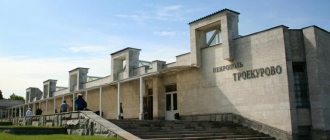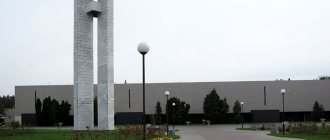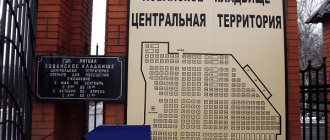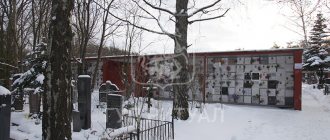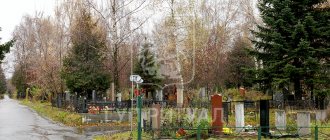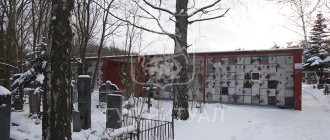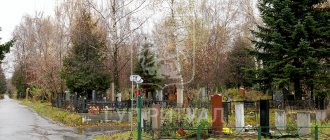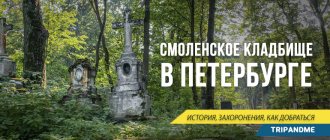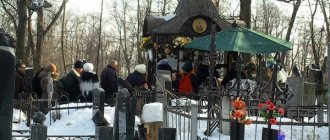The Vagankovskoe cemetery is an ancient Moscow necropolis, founded not far from the palace village of Vagankovo. The first to be buried in this area were the royal servants - amusements and hounds. 80 years later, the churchyard became an official burial site - this site was identified as one of 20 plague cemeteries. Those who died from the Black Death were buried here in unmarked mass graves. Later, in the 30s of the 19th century, when there was an outbreak of cholera, those who died from this infection were brought here. Half a century later, the necropolis became the final resting place for the victims of the stampede on Khodynskoye Field during the coronation of Emperor Nicholas II. During the years of repression, the bodies of those executed in the dungeons of the NKVD were secretly buried here.
Nowadays the Vagankovsky necropolis is considered elite. Thousands of famous people are buried here - poets, actors, athletes, outstanding scientists. There are 259 cultural heritage sites in the cemetery. Since 2019, a tour desk has been opened here and the churchyard has rightfully become considered the most visited in Moscow and Russia.
Story
According to the ancient Christian tradition, necropolises in Rus' arose around churches and were usually located within the city limits. During epidemics, burying in such cemeteries was dangerous due to the risk of repeated outbreaks of the disease. Therefore, victims of epidemics were buried outside the city limits. The history of the Vagankovsky cemetery is connected with the plague epidemic in Moscow in 1771, which claimed thousands of lives. Panic reigned in the city, people were afraid to leave their houses, plague-ridden corpses were thrown directly into the street. They were collected with sticks with hooks by prisoners brought in for this purpose, dressed in solid waxed robes with slits for the eyes.
Empress Catherine II sent Count G. Orlov to Moscow to combat the consequences of the epidemic. By his order, more than ten cemeteries outside the city were organized. One of them appeared in the village of Novoye Vagankovo. On its territory, the dead were buried in deep common graves. New Vagankovo was formed at the beginning of the 17th century in connection with the movement of the sovereign's Kennel Yard outside the city limits. Before that, it was located in the village of Vagankovo along with the Poteshny Dvor. Since the 14th century, “amusing people” have lived there: buffoons, jesters, actors. They were distinguished by noisy behavior, revelry, fist fights, and drunkenness flourished.
By the 17th century, Moscow had expanded, and Vagankovo ended up next to the boyars' chambers not far from the Kremlin. It was located on the site of the current Library. Lenin. Since the Kennel Yard, consisting of 300 hounds, falconers and other servants, in whose care there were falcons and huge packs of dogs, could not be located within the city limits, they were moved to a nearby suburb west of Presnenskaya Zastava (5 km from Vagankovo). So in 1636 New Vagankovo appeared. It existed until 1695, until the Psarny Yard moved. Now in its place is the Vagankovskoye cemetery, which borrowed its name from the village. The official date of formation is considered to be 1771.
Until the 19th century, ordinary people were buried in the cemetery: townspeople, peasants, vagabonds, and minor officials. The construction of the majestic Church of the Resurrection of the Word in 1831 marked the beginning of the burial of nobles and celebrities. By this time, many Moscow churchyards were closed or moved outside the city due to overcrowding, and the Vagankovskoye cemetery from the outskirts moved into the city limits and was active. Over the 247 years of its existence, about 500 thousand people were buried there. Now there are 100 thousand graves in the memorial complex.
Sonka the Goldhand
The grave of the famous adventuress of the past, Sonya the Golden Hand (Sofia Bluvshtein) at the Vagankovskoye cemetery is a legendary place and actively visited. There are different opinions about who is actually buried under the gilded sculpture of a female figure in antique drapery, devoid of arms and head. Nevertheless, the criminal public regularly covers the monument with memorable notes from the Solntsevo gang, requests to teach them how to live, to give happiness to the Zhigan and to pacify the “cops.” People go to this grave, hoping to get lucky in a card game, to save themselves from a knife and a bullet.
Here, at the Vagankovskoe cemetery, under luxurious sculptural tombstones, crime bosses Vyacheslav Ivankovich (“Yaponchik”) and Otari Kvantrishvili are buried.
origin of name
There is no clear version about the origin of the name. There are several of them. The most common hypothesis is related to the word “vaganit”, which, according to Dahl’s dictionary, means: to make laugh, joke, play around. Since “amusing people” lived in Vagankovo, this version is completely justified. Historians associate the name with the collection of a monetary duty for weighing goods on scales (wags).
It is assumed that at this place there was an intersection of important trade roads and a ford across the Moscow River. Nearby there was a customs outpost called “Vaganets”, and the tax itself was called “Vaganny”. According to another version, the name comes from the word “vagan”, which was used to describe simple “uncouth” men.
The Last Heroes of the Soviet Union
Separately, it is worth mentioning the metal sculptural portraits, which are placed on corrugated columns installed on a granite podium. These are the graves of the historically last heroes of the USSR - Ilya Krichevsky, Vladimir Usov and Dmitry Komar. These men died in August 91 of the last century.
The Last Heroes of the Soviet Union
During these terrible events, Dmitry Komar died under the tracks of an infantry fighting vehicle, a bullet ricocheted at Vladimir Usov, and the circumstances of the death of Ilya Krichevsky remain unclear.
Celebrity graves
The Vagankovsky necropolis is known as the burial place of famous people of Russia. The first famous burials appeared in the middle of the 19th century. Here you can see the graves:
- Decembrists, including: M.A. Bestuzheva, P.S. Bobrishcheva-Pushkina, I.N. Khotyaintseva.
- Composer A.N. Verestovsky, author of the immortal opera “Askold’s Grave”.
- Compiler of the explanatory dictionary V.I. Dahl
19th century artists found their eternal resting place:
- Outstanding portrait painter V. A. Tropinin, author of more than 3 thousand paintings, incl. famous portrait of A.S. Pushkin.
- V. I. Surikov, famous for his historical paintings: “Boyaryna Morozova”, “Morning of the Streltsy Execution”, “Suvorov’s Crossing of the Alps”.
- V.V Pukirev, who painted the immortal painting “Unequal Marriage”.
- A.K. Savrasov, author of the works “The Rooks Have Arrived” and “Barge Haulers on the Volga” and many others.
Since the 20th century, actors, directors, writers, artists, politicians and artists have traditionally been buried at Vagankovo. Many outstanding personalities found eternal rest here, including:
- Poets – S. Yesenin, V. Vysotsky, B. Okudzhava, M. Tanich
- Writers – V. Aksenov, G. Gorin, V. Dragunsky, V. Kaverin, V. Rozov
- Directors – V. Pluchek, S. Rostotsky, G. Chukhrai, A. Alov, P. Fomenko
- Actors - A. Abdulov, G. Burkov, Yu. Bogatyrev, G. Vitsin, E. Garin, V. Glagoleva, M. Gluzsky, O. Dal, M. Liepa, A. Mironov, S. Mishulin, T. Nosova, M. Pugovkin, Z. Reich (wife of S. Yesenin), N. Rumyantseva, V. Solomin, L. Sukharevskaya, Z. Fedorova, L. Filatov, M. Tsarev, G. Yumatov.
- Other famous figures are natural scientist K. Timiryazev, academician A. Speransky, journalist and TV presenter V. Listyev, singer I. Talkov, football goalkeeper L. Yashin, figure skater L. Pakhomova.
Necropolis of plots
Photo from places.moscow
Of course, the list of celebrities buried here is not limited to Vysotsky and Yesenin. Decembrist Mikhail Bestuzhev, writer Veniamin Kaverin, artists Vasily Surikov, Vasily Pukirev, Aristarkh Lentulov, conductor Evgeny Svetlanov, director Vsevolod Meyerhold, actors Alexander Abulov, Oleg Dal, Mikhail Kononov, Georgy Yumatov, Spartak Mishulin, Leonid Filatov, coach Anatoly Tarasov, football player Nikolai Starostin, figure skater Lyudmila Pakhomova.
For a long time, a dilapidated wooden cross crowned the grave of the great painter Alexei Savrasov - at the end of his life, he became an alcoholic, became depressed and died all alone in a hospital for the poor. Then a granite obelisk worthy of Alexei Kondratyevich appeared there.
The creator of the famous Museum of Fine Arts, Ivan Vladimirovich Tsvetaev, is also buried here. “According to the will of the deceased, there were no speeches at the grave,” the newspapers reported. Being an incredibly modest person during his life, he remained so even after death.
Director Yuri Zavadsky, in accordance with all his titles, should have rested at Novodevichy. But in his will he clearly indicated: only Vagankovo. Government officials at the highest levels insisted on strict adherence to the cemetery hierarchy. But in the end, the last will of the deceased prevailed.
The Vagankovskoe cemetery is rich in stories.
Military and historical burials
There are many mass graves and mass graves at the Vagankovsky memorial complex. The heroes of the War of 1812, who fell in the Battle of Borodino, the defenders of Moscow in the Great Patriotic War, who did not allow the Nazis to enter the capital, who died in battles and air raids in 1941-1942, are buried here. Not far from the cemetery in May 1896, the Khodynka tragedy occurred, when almost one and a half thousand people were crushed during the distribution of souvenirs in honor of the coronation of Nicholas II. The mutilated corpses were taken to Vagankovo and piled in the meadow. Those who could be recognized were buried by relatives in coffins.
According to the publisher A. Suvorin, “all of this was inflated, black, and the stench was such that it was done badly,” so most remained unrecognized and were buried in common graves at site 6. Here is also the so-called “execution”: those buried according to the “execution lists” received by the cemetery commandant from the OGPU during the years of Stalin’s repressions from 1926 to 1936. The exact number of “enemies of the people” is not known. Burials were made secretly at night in a remote area in a ravine near a stream. Monuments have been erected to the victims of political repression and the Khodynka disaster.
Our contemporaries who died during the 1991 coup and the tragedy that occurred in October 2002 as a result of gas poisoning during the terrorist capture in the theater center on Dubrovka found eternal rest in the cemetery. The graves are located in different areas, only two young actors from the musical rest nearby.
Excursions
Considering the large area of the Vagankovskoye cemetery and the difficulties that tourists may have with navigating among the numerous graves and plots, it is advisable to book a tour of the Vagankovskoye cemetery accompanied by an experienced guide. The necropolis has an ancient and interesting history, which over the centuries has become overgrown with mysteries and mysticism. And who better to talk about this than a professional? In addition, it is easier to visit the most interesting burial sites without spending a lot of time. The average cost of an excursion is from 300 rubles. Duration: two hours.
Saints buried in the cemetery
Orthodox Muscovites preserve the memory of the saints buried in the cemetery, although their graves were wiped off the face of the earth during the persecution of the Church. Despite this, many people come here for help. Especially revered among believers is Valentin Amfitheatrov, rector of the Kremlin Archangel Church, who died in 1908. He does not have a separate burial place; his body rests in a mass grave among WWII soldiers. During the construction of the memorial, the godless authorities ordered the bulldozer to demolish the revered grave. But people remember and honor Father Valentin, they go to him for healing, help and receive it.
Thanks to the efforts of grateful pilgrims, two crosses were erected at the site of the supposed burial. It is known that a Moscow saint, Blessed Schema-nun Martha of Moscow from the St. John the Baptist Monastery, who died in 1638, was buried at Vagankovo in 1927. To avoid desecration of the incorruptible relics by the Bolsheviks, believers reburied them. However, the exact location is not known.
In unknown graves lie glorified saints: Bishop Vasily (Zelentsov) of Priluki, who went through the horror of the Solovetsky camps and was shot in 1930; priest John Inyushin, venerable martyr Macarius (Morzhov), bishop Maxim (Zhizhilenko), executed in June 1931.
Alexander Abdulov
The most popular theater and film artist, an idol who won many hearts, did without doubles during risky filming. The last film with the participation of Alexander Abdulov was called “From Nowhere with Love or Merry Funeral.” It was released in 2007, and in 2008 the actor died at the age of 54 from a serious illness that left no hope.
Above the grave there is a block of grayish-white marble, on which the inscription “Alexander Abdulov” goes in ascending steps of letters. At the top, on a sanded area, there is a black and white portrait of the actor in the image of Lancelot from the parable film “Kill the Dragon.” A relief cross is carved on the side of the monolith.
Not only fans come to Abdulov’s grave, but also those who dream of a brilliant stage career. Rumor has it that the success envisioned here may indeed come, but the price of acting success will be a short life.
Vagankovskoe cemetery in Moscow on the map
- 10 places to visit in Israel
- Tours to Turkey for 12-14 nights, 4-5* hotels, all inclusive from 69,945 rubles for TWO – August
- Trump World Tower in USA
- Castles of Loire
- New Year in Turkey
- Alanya or Antalya
- 25 best excursions in Barcelona
- The most expensive hotels in Dubai
- Grand Kremlin Palace
- 5 best cruises in Europe for the May holidays
- 15 best thermal springs in the Krasnodar region
- Cuba hotels 5 stars all inclusive
